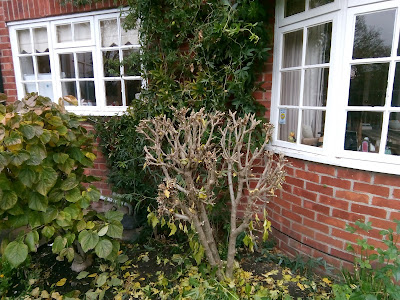When people say "Hibiscus" they usually mean the exotic, tropical, ones, but here in the UK we can grow our own fully hardy Hibiscus - H.syriacus.
They are usually a bit of an under-used shrub, mostly because they are what you might call a one-trick pony: they flower just the once, in late July/August, and that's it.
They are not evergreen, so you don't get winter interest: they are late to come into leaf, so you don't get spring interest, and they don't do anything interesting in autumn, either.
But for those few weeks in summer when they are in full bloom, they are quite delicious: the petals - in shades of blue, lilac or white - are like crumpled silk, and they have a cheeky clump of stamens in the centre, which seem to be sticking their tongues out at us.Being a Mediterranean plant, they need a lot of sunshine - my research suggests that they need at least six hours of sunshine a day to bring them into full bloom, but here in South Oxfordshire, I have several of them in "my" gardens, and as long as they are in a sunny spot (this particular one is against a south-facing wall, perfect!) then they seem to be pretty reliable.
The best place for a shrub Hibiscus is either towards the back of a border, so that their early-season bareness doesn't send the garden owner into a decline (“It's dead! It's dead!”) or standing in splendid isolation, where their stiff upright form can be admired from all angles, and where they get plenty of that sunlight which they crave.
They are extremely easy to care for: they grow fairly slowly, so you don't need to do any complicated pruning, but they can also be cut back in late winter if they are getting in the way, without causing them any harm.
Here's what they look like in late autumn, this was taken last November - left.As you can see, they hold their leaves quite late in the season, but once they start looking like this, I think it's high time for the winter prune.
Personally, I cut "my" ones back quite hard, every year, at any time from later November to early spring, depending on when I have the time... and when I say "quite hard", here is the same shrub after pruning:
As you can see, quite a lot of material removed.
I think of it as another "framework of old wood" pruning job: I go back to the same height every year, removing all the growth from the previous year.
(If I didn't, the garden owner wouldn't be able to see out of the window at all!)
In addition, I'll take out anything which is damaged, or obviously dead: and then sometime I might thin it out in a couple of places, if I think it's getting a wee bit too congested.
After this work, I just rake up all the fallen leaves, and that's it for the winter.
They don't need watering, or special feeding, just a bit of patience in spring (“It's dead! It's dead!”).
In fact, the only thing I don't like about the many Hibiscus (Hibiscusses? Hibiscusi?) in my care is that I have several lilac/blue ones, which send up seedlings all over the place, but the only beautiful white one (which I covet on a weekly basis) has never yet produced any seedlings!
Did you enjoy this article? Did you find it useful? Would you like me to answer your own, personal, gardening question? Become a Patron - just click here - and support me! Or use the Donate button for a one-off donation. If just 10% of my visitors gave me a pound a month, I'd be able to spend a lot more time answering all the questions!!




No comments:
Post a Comment
Comments take around 2 days to appear: please be patient. Excessive SPAM has forced me to restrict comments to just Members: if you have a question, you can become a Member: or you can hop over to Patreon and join me there: or you can email me direct - my email address is in the right-hand pane. Sorry about this, but honestly, the spam! I'm drowning in it!!
Note: only a member of this blog may post a comment.